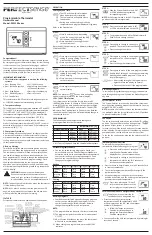
GE
Security
IS-ZW-TSTAT-100 Basic
Thermostat Installation Sheet
Description
The IS-ZW-TSTAT-100 is a digital thermostat that you can control
wirelessly. The IS-ZW-TSTAT-100 operates as a simple thermostat
with buttons to set target temperatures for heat and cool modes.
The thermostat is compatible with standard 24 VAC heating and
cooling systems, up to single-stage heat, one-stage cool. The
thermostat is designed for indoor use only.
© 2010 GE Security, Inc.
1 of 6
P/N 1069534 • REV A • ISS 17MAR10
The thermostat CANNOT be used with a line-voltage system. Line
voltage or high voltage thermostat systems run off your home’s
120 V or 240 VAC power and are not particularly common as they
are used primarily for electric resistance heating systems. The
wires on a line-voltage system will be thicker electrical wires like
those used for a light switch or outlet. Low voltage wiring looks like
telephone or speaker wire. If you are not certain of the type of
system, call an electrician or HVAC service.
The thermostat features include:
•
Two-way communication as part of a Z-wave network can be
controlled both locally and remotely.
•
A Save Energy button adds two more modes for target
temperatures to provide a single button setback mode for
easy operation.
•
The digital thermostat allows you to easily set your desired
heat or cool temperatures on the large screen with the Temp
Up (+) and Temp Down (-) buttons.
Figure 1: IS-ZW-TSTAT-100 Basic Thermostat
Temp up button
Temp down button
Temperature display
Heat/Cool
mode button
Fan button
Gas/Elec switch
Reset
Calibrate
F/C
Z-Wave mate
Terminals
Installation
Caution:
To avoid electrical shock and to prevent damage to the
furnace, air conditioner, and thermostat, disconnect the power
supply before beginning work. You can do this at the circuit
breaker, or at the HVAC system.
Note:
Verify the current system is operating properly before tuning
off the power.
•
Do not turn electricity back on until work is completed.
•
Do not short (jumper) across electric terminals at the control
on the furnace or air conditioner to test the system. This may
damage the thermostat.
•
All wiring must conform to local codes and ordinances.
•
The thermostat relay load should be limited to 1.0 amp;
higher amperage may cause damage to the thermostat.
Tools
You will need a small Phillips screwdriver.
New construction installations
For new installations (new construction), contact your local HVAC
or electrician to wire and mount the thermostat.
For new installations and for relocating an existing thermostat,
follow these guidelines:
•
Determine what type of HVAC system you have.
•
Locate the thermostat on an inside wall, about 5 ft. (1.5 m)
above the floor.
•
Do not locate the thermostat in unusual heating conditions.
•
Do not locate in unusual cooling conditions.
•
Do not locate the thermostat in a damp area. This can lead to
corrosion that will shorten the thermostat life.
•
Do not locate the thermostat where air circulation is poor.
•
Do not install the thermostat until all construction and
painting is completed.
The thermostat does not require leveling.
























